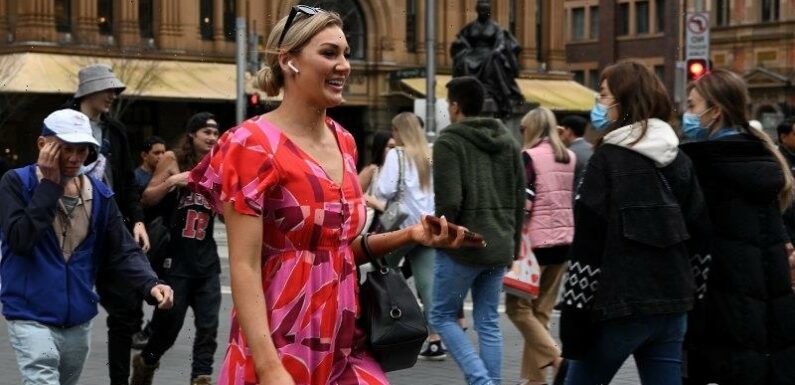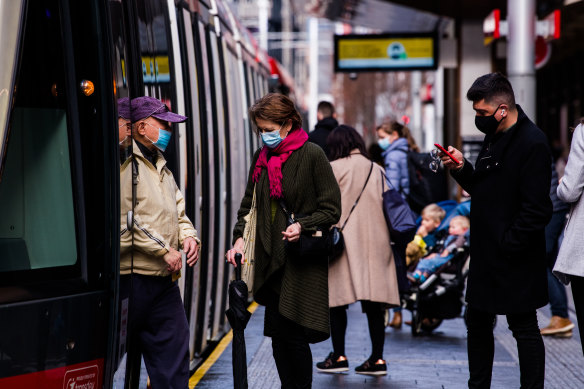
The ending of mandatory isolation for COVID-19 – if that is what happens at national cabinet on Friday – is a milestone worth marking. After two years and 10 months of the pandemic, the most onerous restrictions are essentially gone.
Australia’s borders are open, even to the unvaccinated. We’re no longer required to mask in public – not even on public transport. Lockdowns are a distant memory.
Most of the onerous COVID restrictions are a thing of the past. Credit: James Brickwood
The virus does not care. It remains with us. Despite NSW Premier Dominic Perrottet’s preference for trusting people to stay home when they’re sick instead of forcing their compliance, scrapping mandatory isolation rules will inevitably mean more people with COVID will be out in the community and infecting others.
Some will be asymptomatic, spreading the virus unwittingly, and others will have ignored health advice to stay home.
Epidemiologists also fear it may impair our ability to test for, and react quickly to, any new, more-virulent variant.
Scientists can present us with the evidence, but it’s the community – via politicians – that will ultimately decide what to do with it.
“Just look at the casual attitude to COVID we have at the moment. That’s clearly the prevailing view across the political and business spectrum and wider society,” Burnet Institute director Brendan Crabb said.
“Do Australians know the last wave was our most lethal? Do they know a lot more died in July and August than at any other stage in the pandemic? Do they know the advancing science of long COVID? I’m not hearing it a lot,” he said.
Public health policy protects our health – but it needs to balance that with protecting freedom and fairness.
When we knew nothing about the virus and had no protection from it, there was a clear argument for tough restrictions.
Some 96 per cent of Australians have now received two doses of the vaccine and despite the rise of the variants, that provides excellent defence against serious infection and death. We also have antivirals for those most vulnerable. As a community, we have dramatically reduced our risk from COVID-19.
Given the reduction in risk, rebalancing our public health policy makes sense.
If we are truly living with the virus, then some of the steps to prevent transmission clearly make less sense. Why keep people in quarantine if they are just going to get sick anyway? Why stop people going to work when it is the most-vulnerable who generally lack the paid sick leave needed to stay home without financial penalty? We don’t force people with the flu to undertake mandatory quarantine.
Does the burden that mandatory isolation places on the community outweigh the harm it prevents? Different people – with different vulnerabilities to the virus – will have different answers.
“And people’s risks are not individual,” says University of Adelaide medical ethicist Dr David Hunter. “They depend on the behaviours of other people. So it’s slightly false to say ‘it’s up to you to mitigate your risk’. Because, depending on the situation you’re in, you may not be able to.”
The federal government, meanwhile, would sorely like to stop paying pandemic leave payments to people who miss work to stay at home with COVID.
The scheme cost the government $2.2 billion by the time national cabinet agreed to shorten the isolation period from seven to five days. The longer mandatory isolation remains the place, the greater the cost to the budget.
Australians have gradually lost their appetite for blanket restrictions, but more tailored isolation rules might be easier to swallow. For instance, it makes more sense to keep mandatory isolation rules in place – and leave payments.
What is often forgotten when we talk about “living with COVID” is that some people still face the very real threat of dying. They include immunocompromised children and young adults for whom lockdown has never ended.
Javeria Ahmad, mother to a seven-year-old boy with a severely weakened immune system, said the early days of the pandemic meant people finally understood her family’s tenuous relationship with freedom – the isolation, the frequent sanitising, the social distancing and a constant fear of contracting a deadly virus.
But as restrictions are removed one by one, the risk to her son, Ismaeel, grows – and their world gets smaller and smaller. They will be many elderly and immunocompromised people feeling the same way, even as the rest of us welcome the beginning of the end of the pandemic.
The Morning Edition newsletter is our guide to the day’s most important and interesting stories, analysis and insights. Sign up here.
Most Viewed in National
From our partners
Source: Read Full Article
